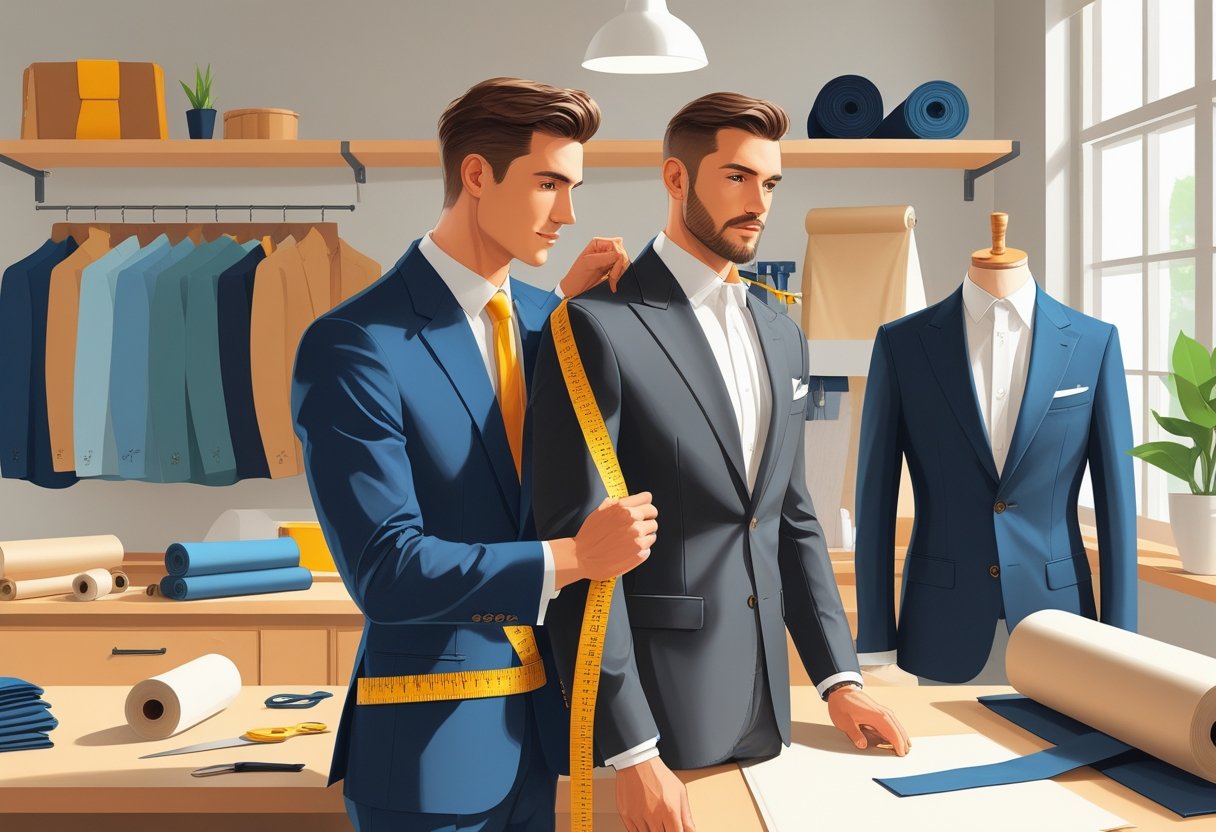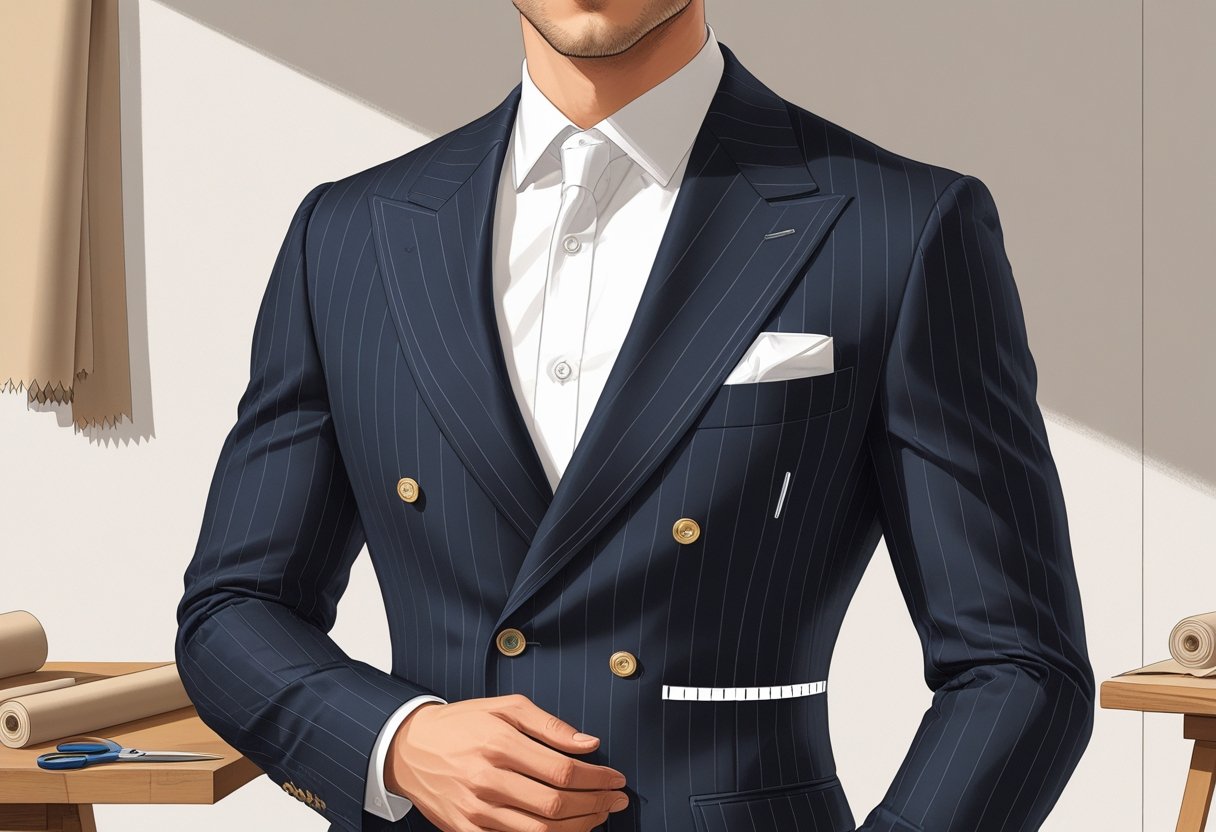A perfectly fitting suit isn’t just about style—it really shapes how a man is seen and how he feels. Tailoring is non-negotiable because it makes sure every part of the suit fits the wearer’s body precisely, giving a polished and confident look that off-the-rack clothing just can’t match.
Without the right fit, even the priciest suit can look sloppy or feel uncomfortable. There’s no shortcut here.

The secret’s in those careful tweaks to the shoulders, chest, and waist. They work together to create a sharp silhouette, and honestly, only skilled tailoring can make that happen.
It’s wild how much the structure of a suit—and even your posture—can improve with a few expert adjustments. When a man walks in wearing a tailored suit, it’s like he’s making a statement before saying a word.
Key Takeways
- Precision in fit makes a suit look sharp and feel comfortable.
- Tailored adjustments to key areas create a balanced and confident silhouette.
- Expert tailoring enhances professionalism and long-term style.
The Importance of Tailoring in Men’s Style
A perfectly tailored outfit just fits the body right—it’s not magic, but it almost feels like it. Tailoring shapes clothing to your unique proportions and helps you look polished, not like you borrowed someone else’s jacket.
Getting clothes altered means you don’t have to settle for whatever the store thinks “medium” means. There’s a balance between comfort and style that you just can’t get off-the-rack.
Fit Versus Off-the-Rack
Off-the-rack clothes? They’re made for some imaginary “average” guy. Most men end up with shirts too baggy or pants that pinch in weird places.
Tailoring fixes these issues. Suddenly, the shoulders line up, sleeves actually hit your wrist, and trousers don’t look like you’re five years old playing dress-up.
Unlike those generic sizes, tailoring gives a custom fit that honestly just feels better. It’s the difference between “meh” and “wow.”
Personalization and Confidence
Tailoring’s not just about measurements; it’s about making your clothes feel like you. When you wear something that’s adjusted for your size, confidence just sort of happens.
Tailors can tweak details—collar size, lapel width, a little extra taper in the pants. These touches make your look feel intentional, not accidental.
That confidence? It shows in your posture, how you walk, how you talk. It’s not just about looking good—it’s about feeling sharp.
First Impressions and Lasting Impact
The way a man’s clothes fit? People notice it instantly. A tailored outfit says, “Hey, I care about details.”
Good tailoring keeps distractions—like saggy sleeves or pants that puddle—out of the picture. Crisp lines and proper fits just make you look more reliable.
Well-tailored clothes don’t just flatter you; they tell the world you respect yourself and whoever you’re meeting. That’s not something you get from a department store rack.
Hey, if you’re enjoying this, why not join my newsletter? Every week, you’ll get three pieces of style inspiration, the latest news, events, trends, and a deep dive into dressing, being, and living better—straight to your inbox. Don’t miss out.
Why Fit Cannot Be Compromised
A well-fitted garment really changes how a man looks and feels. The right fit highlights your best features and gives you comfort—plus a little boost of confidence.
Ignore fit, and you risk ruining even the fanciest clothes. It’s kind of brutal, but true.
How Proper Fit Elevates Appearance
Proper fit shapes the body without extra fabric or awkward tightness. A tailored suit hugs the shoulders, chest, and waist just right.
Ill-fitting clothes? They bunch up, sag, or stretch weirdly. It’s distracting and kind of ruins the whole vibe.
When everything lines up—sleeves, trousers, the whole deal—you just look taller and more put-together. Tailoring is the shortcut to looking sharp, even if your outfit’s pretty simple.
Psychological Advantages of a Tailored Fit
Wearing clothes that fit well? It’s a confidence booster, no question. Men feel more comfortable and poised in tailored clothing.
There’s less anxiety about how you look or whether your shirt’s riding up. Comfort lets you actually focus on, well, life.
Tailoring says, “I pay attention.” People pick up on that. It opens doors, both socially and professionally, more than we like to admit.
Common Problems with Ill-Fitting Suits
You can spot an ill-fitting suit a mile away. Here’s what usually goes wrong:
- Excess fabric around the waist or sleeves that bunches up
- Tightness in the chest restricting movement and causing discomfort
- Shoulder seams that drop too low or are too high, disrupting balance
- Trouser length that is either too short or breaks unevenly over shoes
These issues throw off the whole look. Suddenly, even an expensive suit looks careless.
Fixing these? That’s what tailors are for. A properly tailored suit just eliminates all that mess.
Inside a Tailored Suit: Key Components
A tailored suit is all about how its parts fit together. Every detail—from shoulders to jacket and trouser length—changes how you look and move.
Paying attention to these areas isn’t just nitpicking. It’s how a suit makes you look your best.
The Role of Perfectly Fitted Shoulders
Shoulders are the suit’s foundation. The seam where the sleeve meets the shoulder needs to hit right at the edge of your natural shoulder.
If it’s off—even a little—the whole jacket looks wrong. Too far, and it’s oversized. Too short, and you look squeezed in.
The fabric should sit smooth, no weird wrinkles or bunching. Shoulder alterations are tricky and pricey, so get this part right from the start.
Chest and Waist for a Sculpted Silhouette
The jacket should follow your chest and waist, no pulling or gaping. Button it up—if you can fit a fist comfortably between your chest and the fabric, you’re in good shape.
The waistline gives the jacket its shape. The top button should sit at or just above your natural waist to frame that classic silhouette.
Get this right, and you avoid the dreaded boxy or baggy look. Nobody wants that.
Precision in Jacket and Trouser Length
Jacket length matters for balance. Ideally, the hem covers the seat and lands around the middle of your thumb with arms relaxed.
That classic length works for most guys. It just looks right.
Trousers need love too. Waistband should sit at your natural waist, not pinching or sagging.
The hem? It should just touch the top of your shoes with a slight break—no puddles of fabric. A gentle taper from thigh to ankle sharpens the look.
Details That Define a Tailored Suit

The real magic of a tailored suit is in the details. Small things—lapel shape, fabric, finishing touches—change how it fits, moves, and feels.
Lapels: Shape, Width, and Style
Lapels are a big deal. They come in notch, peak, or shawl shapes.
Notch lapels are classic, peak lapels feel a bit more formal, and shawl lapels are usually for tuxedos. Width matters too—slim lapels look modern, wider ones suit broader shoulders.
Tailors match lapel style and width to your proportions for a look that actually works. A well-rolled lapel follows your chest’s line, and subtle edge stitching adds durability without bulk.
Fabric Selection and Its Influence on Fit
Fabric changes everything. Tailors like wool, cotton, or blends for their weight, stretch, and breathability.
Wool’s popular because it holds shape and drapes nicely. Heavier fabrics give structure but can feel stiff, while lighter ones move better but wrinkle more easily.
Stretch fabrics are a lifesaver if you want comfort in a slim fit. Texture matters too—smooth fabrics look sharp, textured ones like tweed add dimension but can bulk you up a bit.
Pick the right fabric, and your suit just works—fits well, feels good, and suits your climate.
Finishing Touches: Buttons, Pockets, and Lining
Buttons finish the look. Horn, mother-of-pearl, or metal—quality matters here.
Button number and placement affect how formal the suit feels. Single-breasted suits usually have two or three buttons.
Pockets have options: flap (classic), jetted (sleek), or patch (casual). Choose what fits your vibe.
Lining’s not just for comfort; it helps the suit keep its shape and makes it easy to slip on. Silk or acetate linings are breathable and durable.
All these touches tie the suit together, making it look neat, practical, and pretty refined.
Curious about more secrets behind a perfect fit? Check out the hidden secrets of a perfect tailored suit.
The Value of Expertise: Why Professional Tailoring Matters

Professional tailoring is a game-changer. It transforms clothes so they actually fit, and the difference is obvious.
A good tailor knows how to make clothes complement your body and style. Understanding your options helps you pick what fits your life, not just your closet.
Want more tips, inspiration, and the latest in style delivered weekly? Join my newsletter—you’ll get three pieces of style inspiration, news, events, trends, plus deep dives on dressing, being, and living better. Sign up and let’s make style personal.
Benefits of Skillful Tailors
A skilled tailor takes your measurements with care, making sure your clothes fit just right. This means no more awkward tight spots or bunchy fabric—something you can’t always count on with off-the-rack pieces.
They can tweak shoulders, sleeves, waistlines, and hems to really balance your silhouette. Tailors even pay attention to how you stand and move, so your clothes feel as good as they look.
It’s not just about fit, though. A great tailor can elevate a basic outfit, letting your personality and style shine through, whether it’s for work or something special.
Bespoke vs. Made-to-Measure vs. Off-the-Rack
Off-the-rack clothes are made in standard sizes and usually cost less. The trade-off? You’ll probably need some alterations to get them fitting decently.
Made-to-measure is a step up. It starts with a pattern that gets adjusted to your measurements, so the fit is better, but don’t expect unlimited options.
Bespoke tailoring is the top tier. Here, the tailor builds your garment from scratch, using your measurements and preferences, letting you pick fabrics and details that are totally your own.
| Type | Fit Quality | Customization | Price Range |
|---|---|---|---|
| Off-the-Rack | Basic fit | Minimal | Low |
| Made-to-Measure | Better fit | Some customization | Moderate |
| Bespoke | Perfect fit | Full customization | High |
Maintaining Your Tailored Look Over Time
Even the best suit needs a little TLC to stay sharp. Over time, you’ll want to check in on fit and make adjustments as needed.
Caring for Tailored Suits
Be gentle with your tailored pieces. Hang them up on wide, padded hangers—those skinny wire ones are a no-go if you want to keep the shoulders looking crisp.
Try not to overdo it with the dry cleaning. Too many trips can wear out the fabric, so spot clean and air out your suit between wears whenever possible.
If you’re putting your suit away for a while, use a breathable garment bag. Skip the plastic covers—they just trap moisture and can mess with the fabric over time.
When and How to Alter Your Suits
Your body changes, so your suit might need a little tweaking now and then. Maybe it’s the sleeves, maybe it’s the waist—small updates can make a big difference.
Honestly, it’s worth finding a tailor you trust for these fixes. They’ll spot what needs work and keep everything looking fresh. Catching loose seams or worn spots early can save you headaches later.
Frequently Asked Questions
Tailoring really transforms the fit and feel of men’s clothing. It’s all about those little adjustments that make a suit feel made for you.
How does tailoring enhance the overall appearance of men’s clothing?
It sharpens up your look. Tailoring trims away extra fabric and shapes your clothes to you, so you look more polished—like you actually meant to dress this well.
What are the essential alterations a tailor can perform on men’s suits?
Think hemming pants, shortening sleeves, nipping in the waist, or adjusting the shoulders. These tweaks make sure your suit fits cleanly across your frame.
Is it necessary to schedule an appointment before visiting a tailor for adjustments?
Usually, yes. Booking ahead means you get the attention you need, and you won’t be stuck waiting around.
Why is it important to have a suit tailored rather than buying off the rack?
Off-the-rack suits just aren’t made for your body. Tailoring makes a suit feel like it was designed for you, giving you comfort and confidence that lasts.
Can tailoring improve the comfort of men’s formal attire?
Definitely. With a proper fit, you can move, sit, and stand without feeling restricted or awkward.
If you enjoy diving into the details of dressing well and want more style inspiration, why not join my newsletter? Each week, you’ll get three fresh ideas to up your style game, the latest news and trends, and a deep dive into living and dressing better. It’s free, it’s personal, and it’s all about helping you look and feel your best. Sign up and let’s make getting dressed the best part of your day.
What should one expect from the before and after results of professional tailoring?
Before tailoring, your clothes might hang awkwardly or pinch in all the wrong spots. Maybe the sleeves droop, or the hem just doesn’t sit right.
But after a good tailor gets their hands on it? Suddenly, the garment skims your shape, lines fall where they should, and the whole look just feels… right. It’s honestly kind of wild how much of a difference it makes—style and confidence get a serious upgrade.
Curious about more ways to dress better, live better, and just feel better? Join my newsletter for a weekly dose of style inspiration, the latest news, events, and a deeper look at the world of personal style. You’ll get three fresh ideas every week—don’t miss out!
This paragraph serves as an introduction to your blog post. Begin by discussing the primary theme or topic that you plan to cover, ensuring it captures the reader’s interest from the very first sentence. Share a brief overview that highlights why this topic is important and how it can provide value. Use this space to set the tone for the rest of the article, preparing readers for the journey ahead. Keep your language approachable, yet informative, to create a strong connection.
Sometimes, the simplest moments hold the deepest wisdom. Let your thoughts settle, and clarity will find you. Use this quote space to share something inspirational or reflective, perfectly aligned with the theme of your article.
This paragraph dives deeper into the topic introduced earlier, expanding on the main idea with examples, analysis, or additional context. Use this section to elaborate on specific points, ensuring that each sentence builds on the last to maintain a cohesive flow. You can include data, anecdotes, or expert opinions to reinforce your claims. Keep your language concise but descriptive enough to keep readers engaged. This is where the substance of your article begins to take shape.


As you move toward the midpoint of the article, this paragraph provides an opportunity to connect earlier ideas with new insights. Use this space to present alternative perspectives or address potential questions readers might have. Strike a balance between depth and readability, ensuring the information remains digestible. This section can also serve as a transition to the closing points, maintaining momentum as you steer the discussion to its final stages.
Wrapping Up with Key Insights
In this concluding paragraph, summarize the key takeaways from your article, reinforcing the most important ideas discussed. Encourage readers to reflect on the insights shared, or offer actionable advice they can apply in their own lives. This is your chance to leave a lasting impression, so make sure your closing thoughts are impactful and memorable. A strong conclusion not only ties the article together but also inspires readers to engage further.


Leave a Reply